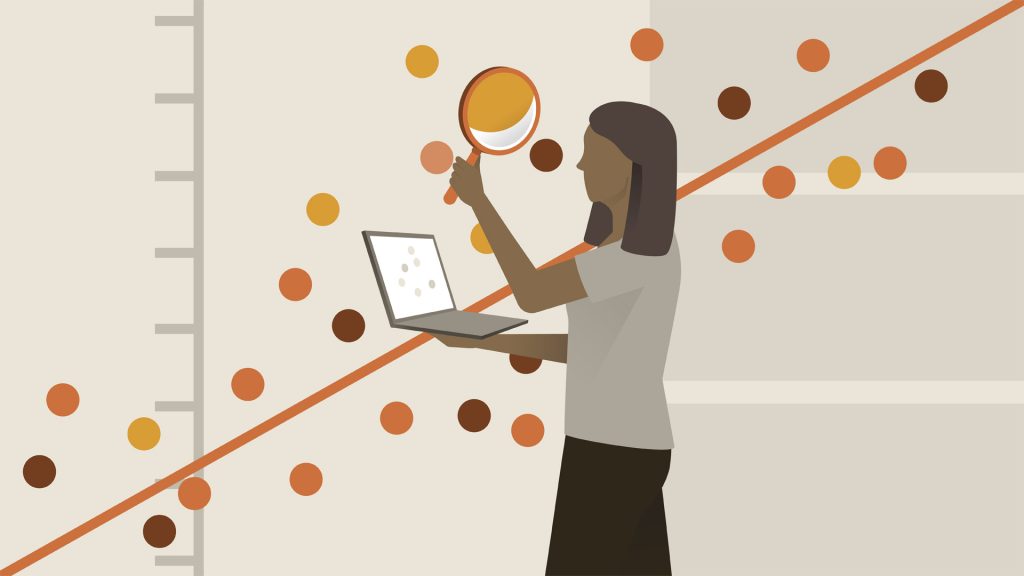One of the most important aspects of any business is understanding how different variables impact performance. This can be done through regression analysis, a process that allows you to study the relationship between different factors and see how they impact each other. In this blog post, we will discuss what regression analysis is, and how you can use it to improve your online business!
What regression analysis is
Regression analysis is one of the most powerful statistical methods that can be used to study the relationship between different factors and see how they impact each other. It allows you to control for confounding variables and see how changes in one factor can affect another. This can be extremely helpful in improving the performance of your ecommerce site.
In a regression analysis, there would be multiple data points plotted on a graph. The line of best fit, a regression line, would be drawn through these data points, and the slope of this line would be used to determine the relationship between the two variables. A positive slope would indicate that as one variable increases, the other variable also increases. A negative slope would indicate that as one variable increases, the other decreases.

A regression line can be used to make predictions about how changes in one variable will affect another. For example, if you wanted to know how changes in advertising spending would affect sales, you could use regression analysis to study this relationship.
The different types of regressions for your online store
There are different types of regressions that you can use depending on the type of data you have and the question you want to answer. The most common types of regressions are linear, multiple linear, nonlinear, logistic, and polynomial.
Linear regression
Linear regression analysis is the most common type of regression. It is used to study the relationship between two continuous variables, such as sales and advertising spending.
Multiple linear regression
Multiple linear regression analysis is used to study the relationship between multiple continuous variables. This is helpful if you want to control for confounding variables or see how different factors interact with each other.
Nonlinear regression
Nonlinear regression analysis is used to study the relationship between two variables when the data is not linear. This type of regression can be used to study relationships that are curvilinear or have a nonlinear relationship.
Logistic regression
Logistic regression analysis is used to study the relationship between a categorical variable and a continuous variable. This is helpful if you want to predict the probability of an event occurring, such as whether or not a customer will make a purchase.
Polynomial regression
Polynomial regression analysis is used to study the relationship between a continuous variable and one or more categorical variables (such as gender or location).
Study different variables in your ecommerce business outcomes
There are a number of different ways to use regression analysis to boost your retail ecommerce sales. While one of the most common methods is to study the effect of multiple independent variables on a single dependent variable, there are a number of different ways to do this. For example, you could use regression analysis to study the effect of advertising, price, and product quality on online sales.
Another way to use regression analysis is to study the effect of a single independent variable on multiple dependent variables. For example, you could use regression analysis to study the effect of advertising on sales, profits, and customer satisfaction.
Finally, you can also use regression analysis to study the interaction between two or more independent variables. For example, you could use regression analysis to study the effect of advertising and price on sales.
No matter how you use regression analysis, it is a powerful tool that can help you better understand the relationships between different variables in your business. By understanding these relationships, you can make better decisions about how to grow your business and improve your bottom line.
The business problems regression analysis can solve
Global retail ecommerce sales are on the rise. The degree of competition on each ecommerce platform has been increasing.
To stand out from the competition in electronic commerce, ecommerce businesses must address as many business issues as possible. Regression analysis can be utilized to solve a variety of business difficulties for an ecommerce store, including:
Forecasting future sales
One of the main uses of regression analysis is forecasting future sales. You can use past sales data to predict how much product you will sell in the future. This can help you plan for future production needs, budget for advertising, and make other strategic decisions.
Identifying which marketing activities are most effective
Want to know which marketing activities are most effective? Regression analysis can help. By analyzing past sales data, you can identify which activities are most likely to result in increased sales. This knowledge can help you focus your marketing efforts and achieve better results.
Determining what factors influence customer satisfaction
The factors that influence customer satisfaction can be determined through regression analysis. By analyzing past sales data, you can identify which factors are most likely to result in increased satisfaction. This knowledge can help you focus your efforts to improve customer satisfaction.
Quantifying the financial impact of changes in business operations
One of the most important applications of regression analysis is quantifying the financial impact of changes in business operations. For example, if you want to know the effect of increasing the price of your product on sales, you can use regression analysis to calculate it. This information can be very helpful in making business decisions.
Tips for interpreting regression results and using them to improve your business
Once you have run a regression analysis, you will need to interpret the results. This can be tricky, especially if you are not familiar with statistics. Here are some tips for interpreting regression results:
1. Look at the coefficients. The coefficients are the most important part of the regression results. They tell you how strong the relationship is between the independent and dependent variables.
2. Look at the p-value. The p-value is a measure of how likely it is that the results are due to chance. If the p-value is low, then there is a strong correlation between the variables. If the p-value is high, then there is no correlation.
3. Look at the R-squared value. The R-squared value tells you how much of the variance in the dependent variable can be explained by the independent variables. The higher the R-squared value, the better the model is at explaining the data.
4. Check for outliers and multicollinearity. Outliers can distort the results of regression analysis, and multicollinearity can make it difficult to determine which independent variable is having the most impact on the dependent variable.
5. Use caution when interpreting coefficients that are close to zero. Coefficients that are close to zero may not be statistically significant, so you should not put too much weight on them.
The limitations of regression analysis
Regression analysis is a powerful tool, but it has its limitations. One of the main limitations is that it is based on historical data. This means that it can only be used to make predictions about the future, not to control or change the future. In other words, regression analysis can tell you what has happened in the past and what is likely to happen in the future, but it cannot tell you what will happen if you change one or more of the variables.
Another limitation of regression analysis is that regression analysis is a complex statistical tool, and it can be difficult to interpret the results. This is why it is important to work with a statistician or data analyst who can help you understand the results of your regression analysis.
This is not to say that regression analysis is not a valuable tool. On the contrary, it is an essential tool for any business that wants to understand the relationships between variables. But it is important to understand its limitations and to use it wisely.
When it should not be used
There are three main situations when regression analysis should not be used:
When you don’t have enough data
Regression analysis requires a large amount of data in order to be accurate. If you don’t have enough data, the results of your regression analysis will be less reliable.
When there is multicollinearity in the data
Multicollinearity occurs when several independent variables in your data are highly correlated with each other. This can lead to inaccurate results from regression analysis.
When the dependent variable is not a continuous variable
Regression analysis can only be used when the dependent variable is a continuous variable (such as income or sales). It cannot be used when the dependent variable is a categorical variable (such as gender or product type).
If you’re not sure whether regression analysis is the right tool for your data, it’s always best to consult with a statistician or data analyst. They will be able to help you understand the limitations of regression analysis and recommend other statistical tools that may be more appropriate for your data.
The different types of errors that can occur in regression analysis
During regression analysis, it is possible that errors can occur. These errors can be classified into two types: Type I and Type II.
Type I error, also known as false positive, occurs when the null hypothesis is rejected even though it is true. This means that there is a relationship between the independent and dependent variables when there actually isn’t one.
Type II error, also known as false negative, occurs when the null hypothesis is not rejected even though it is false. This means that there is no relationship between the independent and dependent variables when there actually is one.
Both types of errors can have serious consequences. Type I error can lead to wrong decisions being made, while Type II error can lead to important relationships being missed. That’s why it’s important to understand the different types of errors that can occur in regression analysis and how to avoid them.
How to avoid errors in regression analysis
There are a few things you can do to avoid errors in regression analysis:
Use a large amount of data: The more data you have, the less likely it is that errors will occur.
Check for multicollinearity: If you suspect that multicollinearity might be a problem, you can use a technique called variance inflation factor (VIF) to check for it.
Use a different statistical tool: If you’re not sure whether regression analysis is the right tool for your data, you can try using a different statistical tool. For example, if you’re working with categorical data, you could try logistic regression instead.
Work with a statistician or data analyst: They will be able to help you understand the limitations of regression analysis and recommend other statistical tools that may be more appropriate for your data.
Conclusion
Regression analysis is a valuable tool for any business that wants to understand the relationships between variables. However, it is important to understand its limitations and to use them wisely. In particular, regression analysis should not be used when you don’t have enough data, when there is multicollinearity in the data, or when the dependent variable is not a continuous variable. By using a large amount of data, checking for multicollinearity, and using other statistical tools as needed, you can avoid the most common errors in regression analysis.
Visit other blogs we published for further helpful knowledge to improve your ecommerce website!

